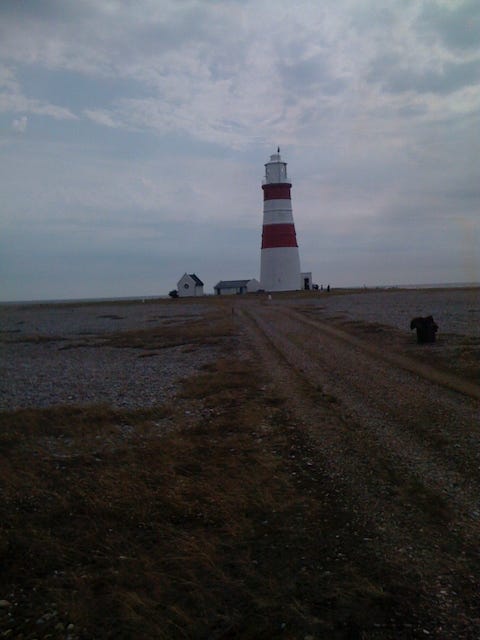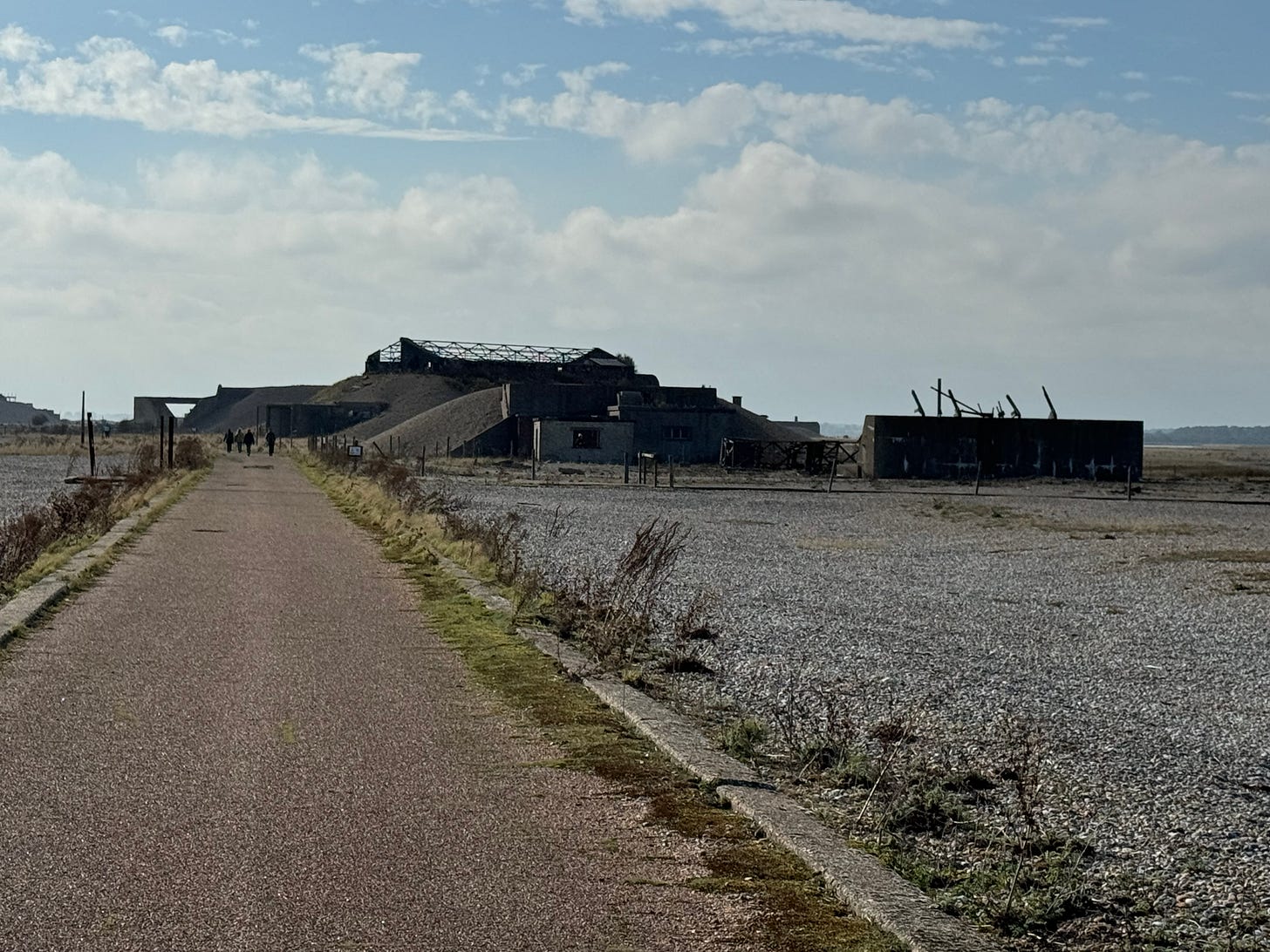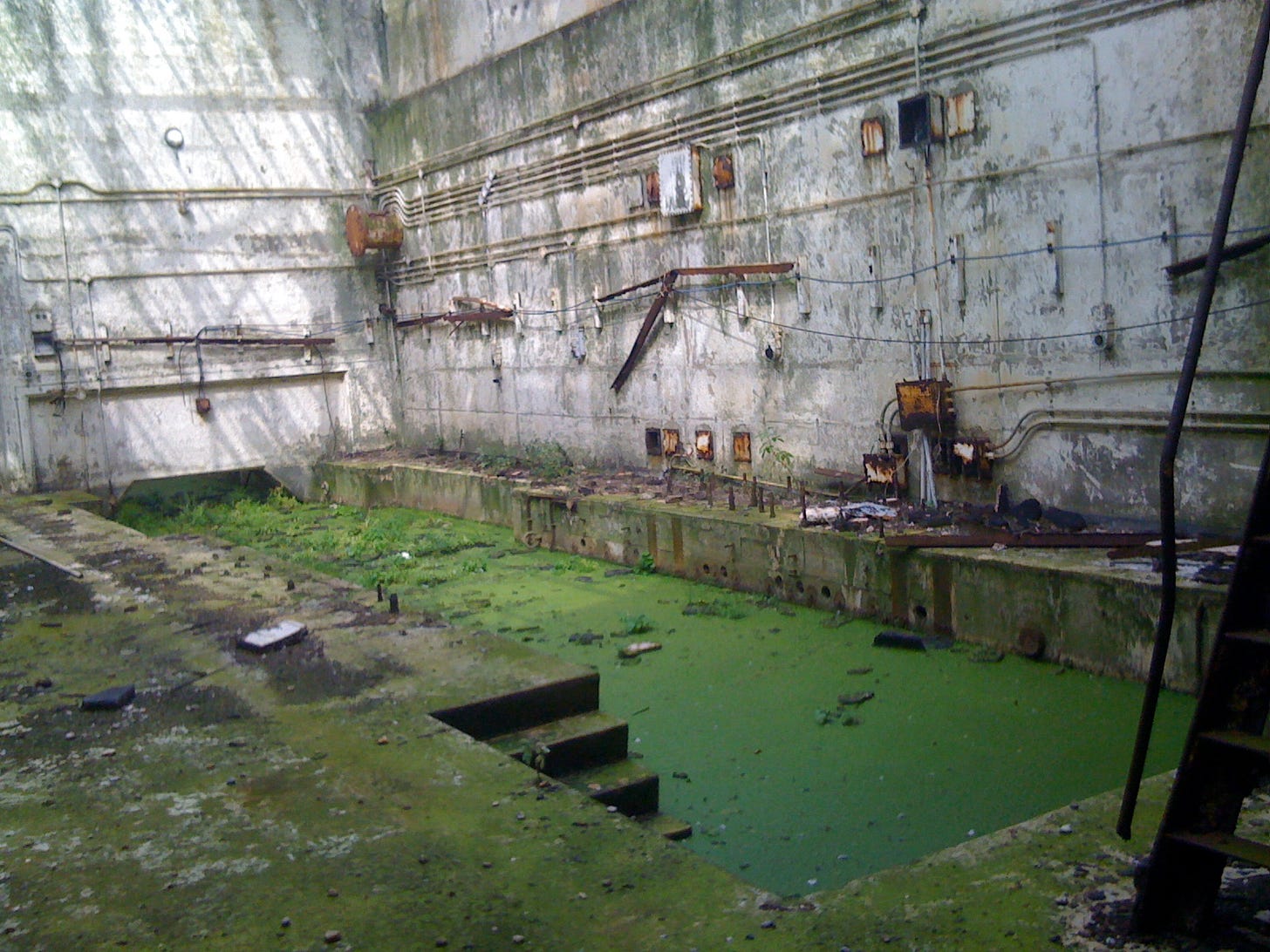Orford Ness revisited
An uncanny shifting landscape (literally)
In one of my early posts I wrote about how I have always been drawn to abandoned landscapes.
It was more recently that I realised that most of these places had rewilded themselves.
And that was what had lured me there in the first place.
I just hadn’t known it at the time.
One of those landscapes was Orford Ness, a spit of land sticking out of the Suffolk coast into the North Sea.
A ‘ness’ is literally a ‘nose’ in Old Norse, a language spoken over a thousand years ago across the sea and over the horizon from Orford.
I first learned about the promontory and its sinister past in W. G. Sebald’s ‘Rings of Saturn’, a book I had studied as part of my Master’s dissertation.
Sebald was a German writer and academic who taught at the University of East Anglia in Norwich just up the road from Orford. His books have haunted me the last 20 years.
My first contact with Sebald’s work was ‘The Emigrants’ which I picked up by chance in a local bookshop.
It appears to document the lives of four Jewish émigrés in the twentieth century. The first story starts with the author coming across an old man in the garden of a house he was seeking to rent a room in.
As this man Henry Selwyn narrates his story, it is clear that the Holocaust floats unspoken in the background starting with his family’s exodus from the cheder in a village near Grodno in Lithuania.
But there was something else I found deeply unsettling about it all on an all too personal level.
The Selwyn family’s entry point was Whitechapel, where my own forebears first lived when they also arrived in England in the 19th century.
They had been led to believe that they were now in New York when they disembarked, their ‘Promised City’. Frederich Stein, my great-great-grandfather came ashore in London under the same mistaken impression.
The young Henry was then put in for and passed the scholarship exams for Merchant Taylors’ school, which I was to do over half a century later. And I then followed the same route as the fictional Dr Selwyn went to Cambridge.
If that wasn’t strange enough, Werner Herzog’s ‘The Enigma of Kaspar Hauser’ features in the story, a film I had literally watched the day before picking up Sebald’s book.
All coincidences I am sure (?) but deeply unsettling, even ‘uncanny’ in the original sense of the word. As is often the case, the German sounds spookier - ‘unheimlich’.
Of course how could I be anything other than hooked on the books of W.G. Sebald from then on.
A couple of years later I tackled ‘The Rings of Saturn’ which traces the author’s efforts to shake off a depression by means of a walk along the coast of East Anglia.
This was my gateway to the mysteries of Orford Ness.
He described the place as: “the god-forsaken loneliness of that outpost in the middle of nowhere’.
Which made me think that the walk didn’t really sort out his depression.
Sebald’s fascination with Orford Ness was a fascination with war and the scars it leaves behind, both physical and human.
The peninsula was a site of military research during both World Wars and the Cold War. It was where radar was invented and atomic weapons were dropped to test the reliability of their componentry.
I returned to the place more recently after a 15 year absence, now for the first time in my nature-awakened state.
The Ness was recognisably the same place. Framed by the same East Anglian sky, the skyline dominated by the town’s 12th century castle built for Henry II.
But that autumn day some things were different. Both because I had a better idea of what I was looking at in terms of nature. But also because the landscape had literally shifted in the intervening years.
It was now a joy to be able to recognise the different birds there.
I was aware of why the swallows were flying in the direction they were that autumn, out to sea rather than inland. Their African homelands and a perilous 8,000 mile journey to get there beckoned.
I could also see and appreciate why the National Trust had closed off much of the shingle beach since the last time I had visited.
Orford Ness holds 20% of Europe’s vegetated shingle in its ridges and valleys, deposited there over centuries. The specialised plants like Sea Thrift and Yellow-Horned Poppy that grow there offer food and shelter for a variety of wildlife including brown hares and Chinese water deer.
Thanks to the closure of the beach, a colony of seals had recently established themselves on the shingle. Previously human presence would have been too intrusive for them and their pups and they would have moved on elsewhere.
There was also another reason why the path no longer ran across the shingle.
Orford Lighthouse used to be one of East Anglia’s most iconic landmarks. For over 200 years it had provided a navigation marker for mariners as that section of the coast had always been hazardous. For example, in 1627, before the construction of the lighthouse, 32 ships had been wrecked there in one single storm.
Despite all the lives saved since, the lighthouse had to be demolished in 2020. The ever-shifting shingle on the Ness meant that if it wasn’t taken down, the lighthouse would fall into the North Sea.
The building I had climbed to the top of in 2009 was no longer there in 2024.


The remaining structures on Orford Ness, with chilling names like the Bomb Ballistic Building or the Black Beacon, now contain an interesting variety of installations and exhibitions.
As well as learning more about the 80 years of occupation for top secret research, there were more reflective pieces.
I found myself nodding in agreement to the display that compared Orford Ness to Tintern Abbey on the banks of the River Wye in the west of England, whose ruins became the symbol of picturesque decay for the Romantic poets of the late 18th century.
For William Wordsworth, for example, it stood in for the changes in English society at the time, from a bucolic Eden to a rapidly industrialising society.
Despite a very different landscape of a wooded river valley, in his poem ‘Lines composed a few miles above Tintern Abbey’ Wordsworth found the landscape could help “connect the landscape to the sky”, as it did for me that day.
But now Orford Ness was proceeding in the opposite direction.
Instead of marching on the path of ‘progress’ towards a bright future of modernity, here was a post-industrial falling away.
As Sebald would have it: “I imagined myself amidst the remains of our own civilisation after its extinction in some future catastrophe”.
Here I felt humanity recognising that the time had come to voluntarily dismantle its structures and let nature do the rest.
For Sebald, the six pagodas on Orford Ness used for atomic weapons tests were where “the mighty and powerful were buried in prehistoric times with all their tools and utensils, silver and gold”.
Yes, here was a “terrain of melancholy” but for me not a place of depression, more a quiet joy that nature was taking back its rightful place.
Here was a place so toxic, literally and metaphorically, that was decontaminating itself with little or no help from us.
To go from being an atomic weapon site to an internationally important coastal nature reserve in less than fifty years was quite a feat.
Take bow, Nature!
I am not sure how much hope I hold out for humanity but my return visit to Orford Ness made me confident that the natural world will sort itself out in the end without us.







Thank you; that's fascinating. I stayed in Orford many years ago, when the Ness was still out of bounds, and therefore grimly fascinating. It's reassuring to think of it recovering.
I went to school just along the coast from Orford, and I love visiting. It's a long way to go these days though, so thank you for the trip down memory lane.